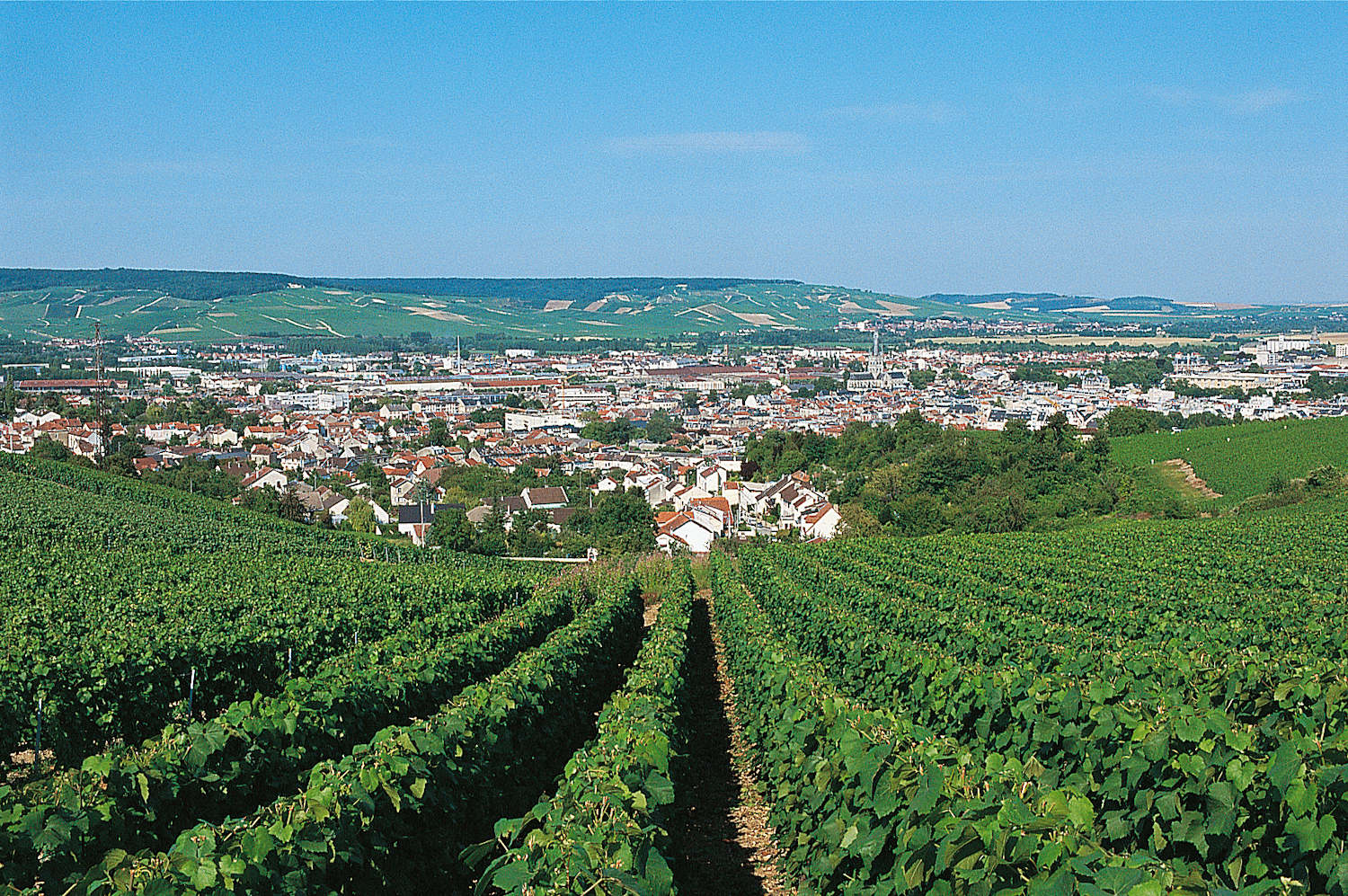
In the vineyards overlooking Epernay, capital of the world’s most famous sparkling wine region. Photo Ville d’Epernay.
Let’s talk about your Champagne education. No, not the neighborly kind offered at your local wine shop. Nor the delightful kind that you can get on a wine bar tour with me in Paris. I’m talking about the well-advised independent kind that a curious traveler—you—can get by visiting the vine-growing area and production zone of the world’s most famous sparkling wine. Yes, I’m talking about your Champagne daytrip or overnight.
For most destinations in the Champagne wine region your coursework on the making and variety of tastes and styles of Champagne requires a road vehicle, whether a rental car, a taxi, a car service or an organized car/van/bus tour—in any case a designated driver.
Let’s say that you’re either setting out from Paris or heading to the Champagne region directly after arriving at Charles de Gaulle Airport. A driving tour can start with the Marne Valley producers around Chateau-Thierry, a zone where pinot meunier vines dominate or by going directly to the heart of the region that lies between and within the two capitals of Champagne: Reims, the historic regional capital, and Epernay, the capital of bubbly itself. Beyond Epernay there’s the Côte des Blancs, especially known for the prestigious chardonnay grapes that grow in its chalky soil. Then there’s the lesser traveled southern portion of the growing area in the department of Aube, specifically the Côte des Bar, with its much-desired pinot noir vineyards.
Each of those areas has its particularities and benefits as destinations to enjoy and learn about Champagne. But how to obtain a good Champagne education without a car or driver? Château-Thierry and Reims are reached easily enough by train, but for the former you then need to hit the road to get credits for your survey course, and for the latter you’d be one weary (though probably happy) foot traveler if you didn’t call for some kind of transportation during the day.
Epernay is the DIY Champagne destination with the best car-free outlook, whether on a daytrip or an overnight.
Not only can a sparkling excursion to Epernay be car-free but carefree as well since little logistical planning is necessary. Most days you can even purchase your train ticket at the last minute at Paris’s East Station, Gare de l’Est, for the one hour and twenty- or thirty-minute ride to Epernay. Greater planning is necessary to climb the Eiffel Tower or visit the Louvre than to explore Epernay on a daytrip.
From the Epernay station, your entire learning campus can easily be covered on foot. Within one mile of the station, you can visit any of a dozen Champagne producers, examine a terrific museum that’s dedicated to regional archeology and the wines of Champagne, see the former mansions of Champagne merchants, and have a choice of restaurants, Champagne bars, pastry shops, and cafés. You can even rise 492 feet in a tethered balloon or climb a 217-foot tower for a view over the valley and out to the vineyards. All within one mile of the train station.
The agro-industrial business of Champagne production dominates in Epernay (pop. 23,000), so if you’re a single-minded traveler looking for an intensive introduction, continuing education or master class in Champagne—without recourse to a car—read on.
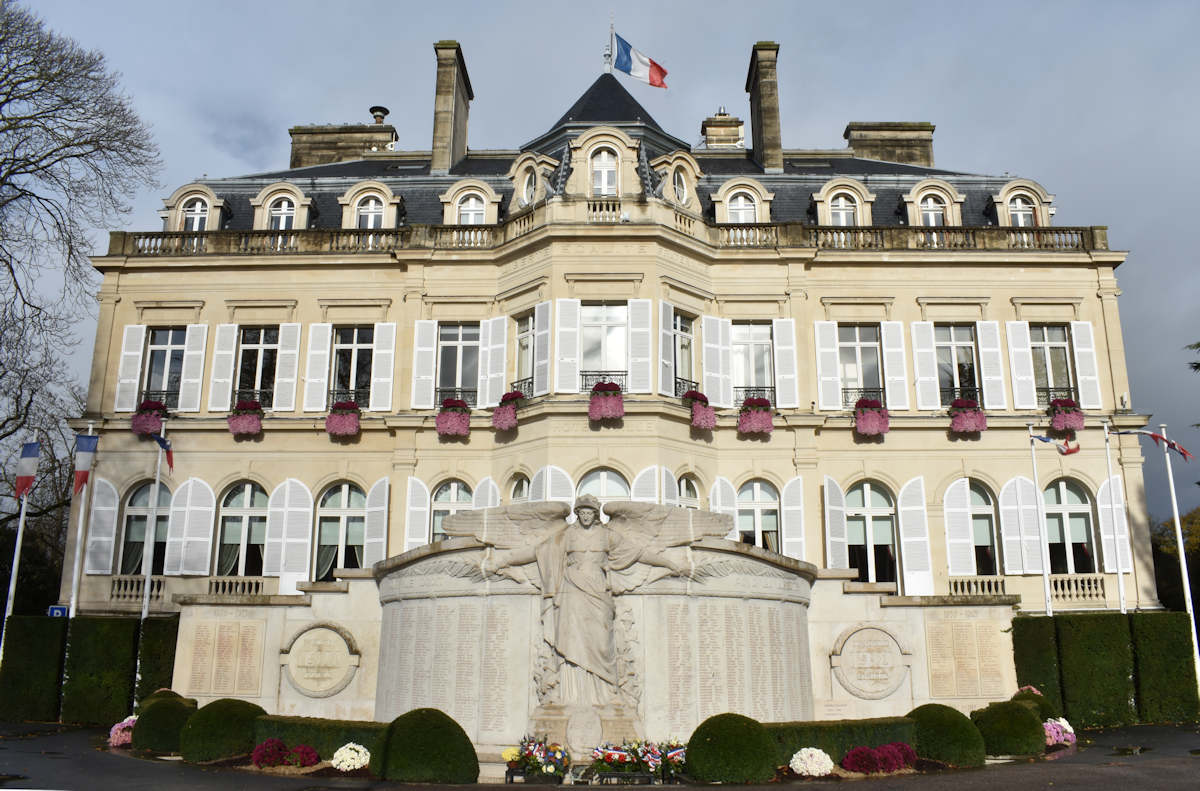
Avenue de Champagne
The essential strolling grounds for a visit to Epernay is Avenue de Champagne, Champagne Avenue. Sparnaciens, as local citizens are called, like to tell visitors from the capital that Avenue de Champagne is the Champs-Elysées of Epernay. Indeed, there’s just as much branding going on. But there’s also deep know-how along, around and beneath Avenue de Champagne. Epernay has nearly 70 miles of cellars underfoot, holding about 200 million bottles of bubbly. The avenue is bordered by the former mansions of Champagne merchants, many of them dating from the 19th century. They’re mostly on the left side as you rise the avenue, while on the right side are production facilities, with plenty of Champagne know-how and marketing expertise on both sides of the street. All of that allows Avenue de Champagne to be among the elements that entered UNESCO’s World Heritage List under the title “Champagne Hillsides, Houses and Cellars.”
You can easily spend half a day or more along the first half-mile of the avenue. Thanks to its many opportunities to learn, see and taste, Champagne Avenue could be your sole destination on a train excursion from Paris. Yet you’ll undoubtedly also enjoy a walkabout in the compact heart of the town with its bakeries, pastry shops, restaurants, cafés and tasting rooms.
The Epernay Tourist Office, at 7 avenue de Champagne, is conveniently located near the bottom of the avenue, so it can be your first stop on arrival. Reservations are recommended to visit a production facility and cellars, especially on busy weekends and in summer, but it’s also possible decide on an Epernay daytrip on a whim, in which case the tourist office can help direct you to an available cellar tour. Your Champagne curriculum calls for at least one such tour, particularly if you aren’t aware of the grapes, their classification and the Champagne method. Other than a formal tour, tasting opportunities are easy to come by, both on the avenue and in the heart of town.
Beyond the tourist office, the first major former mansion you’ll come upon was built for the Auban-Moët family in the second half of the 19th century. You may not know the Aubans but you’ve certainly heard of the Moëts, as in Moët & Chandon, whose installations can be visited right across the street. The mansion has served as City Hall since right after the First World War, which explains the monument to war dead that greets visitors entering on its avenue side. The estate’s park (feel free to enter) has a near replica of the Temple of Love that stands in the Trianon park at Versailles. (When arriving by train, you can actually cut through the park to reach Avenue de Champagne.)
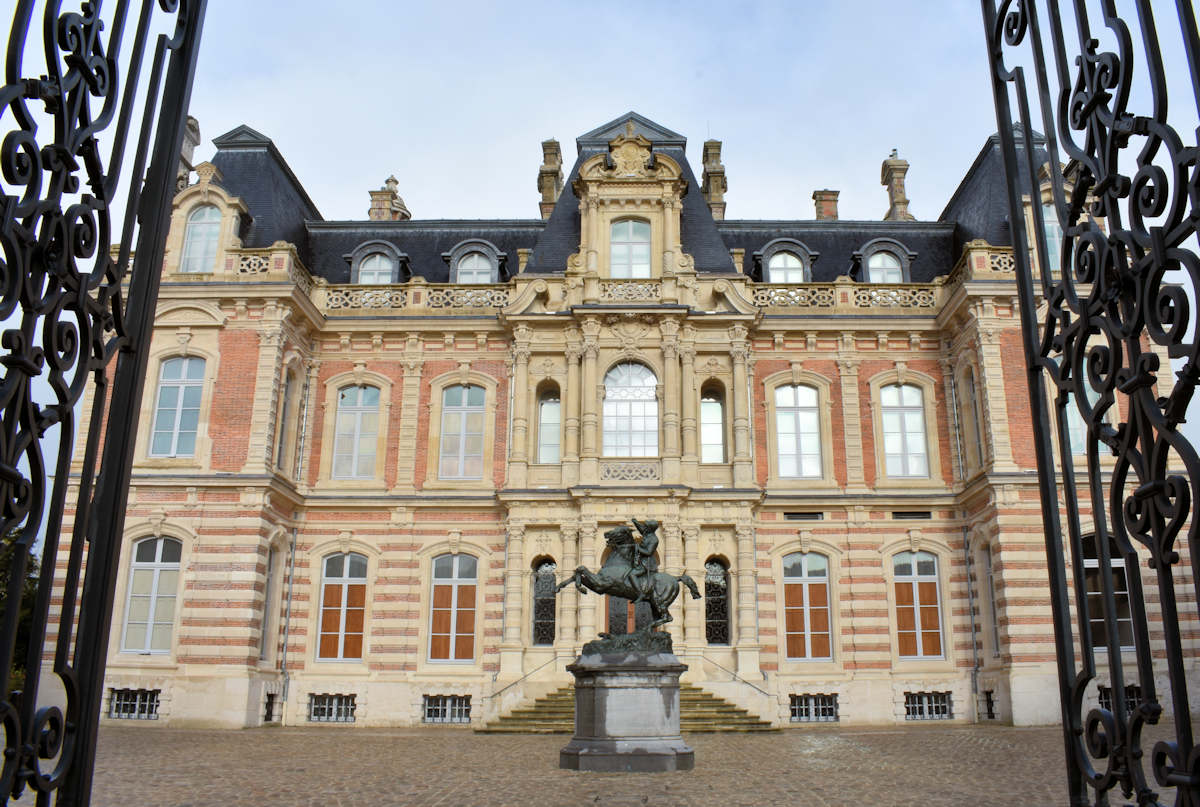
Château Perrier: The Museum of Champagne Wine and Regional Archeology
A 3-minute walk further up the avenue you’ll come to the Château Perrier, an eclectic and ostentatious 96-room mansion built in the 1850s by local architect Pierre-Eugène Cordier for Charles Perrier, heir to the Perrier-Jouët Champagne House. The Perrier-Jouët cellars are partly beneath the mansion. They were dug to connect directly with the railway line that had been inaugurated in 1849. The estate was purchased by the Town of Epernay in 1943 to house its museum collections and library. Closed in 1998 for massive rethinking, reorganization and eventually restoration, it reopened in 2021 as the Museum of Champagne Wine and Regional Archeology.
If arriving by train in the morning, consider the museum as your first stop before lunch or a visit one of the Champagne Houses.
I know, I know, you’ve come for cool bubbles not for a dry museum. But let your curiosity draw you inside. First, to admire the grand staircase and the gold-leaf décor of the ground-floor reception rooms and to take in the view out to the park of Château Perrier and beyond the Marne River to the vine-planted slopes of the Mountain of Reims. Then it’s on to the geology section. Geology? What’s that got to do with my Champagne education? As with all prestigious wine regions, an awful lot! Just ask the roots of the vines and the minerality in your glass. An awareness of the formation of the region’s chalky sub-soil here is an integral part of your Champagne education as is, naturally, the section on winemaking that comes later. Yet the most fascinating part of the museum is the archeology collection (choice Neolithic, Celtic and Roman finds), one of the largest in France. The informative audio-guide, available in English, is especially useful in viewing that section.
Musée du vin de Champagne et d’Archéologie régionale, 13 avenue de Champagne, Epernay. Entrance (includes audio-guide): 9€, 6€ for ages 13 to 25, free for under 13. Closed Tues.

Continuing along the avenue and nearby
Among the most accessible producers for tours and tastings are Moët & Chandon, de Venoge and Boizel on the primary strolling portion of Avenue de Champagne; Alfred Gratien, Jacquinot & Fils and de Castellane on nearby streets, and Mercier and Comtesse Lafond beyond the first half mile of the avenue. Others are further afield but also reachable on foot (e.g. Charles Mignon on the opposite side of town). Still others allow you to pursue your education in their tasting room or bar, e.g. A. Bergère, Leclerc Briant, Elodie D., Les 3 Domaines (which presents the wines of three winemakers).
Whichever you visit, enjoy a stroll along the mannerly first half-mile of Avenue de Champagne to view the mansions and villas along the way. Don’t hesitate to enter an open gate and to inquiry about the bubbly of a producer you may never have heard of.
One of those that I visited on my recent overnight to Epernay was Champagne Boizel. I asked Lionel Boizel, who oversees the Champagne house with his brother Florent, to give readers a virtual tasting. His presentation of three Boizel Champagnes follows my introduction in this video.
Eventually, at a round-about, you’ll come to the turn-off toward the de Castellane Champagne House on the left and the Mercier facility built in the 1980s on the right. Mercier is a major producer with a family-friendly cellar tour. De Castellane, along with its own cellar tour, welcomes visitors of all ages able to climb the tower’s 237 steps for a view over the town and along the River Marne and out to the vineyards along the slopes of the southern side of the hill known as the Mountain of Reims. For an alternative or additional overview, you can lift off (weather permitting) in a tethered balloon (you’ll see it near the start of the avenue) while sipping a glass of bubbly at just under 500 feet.
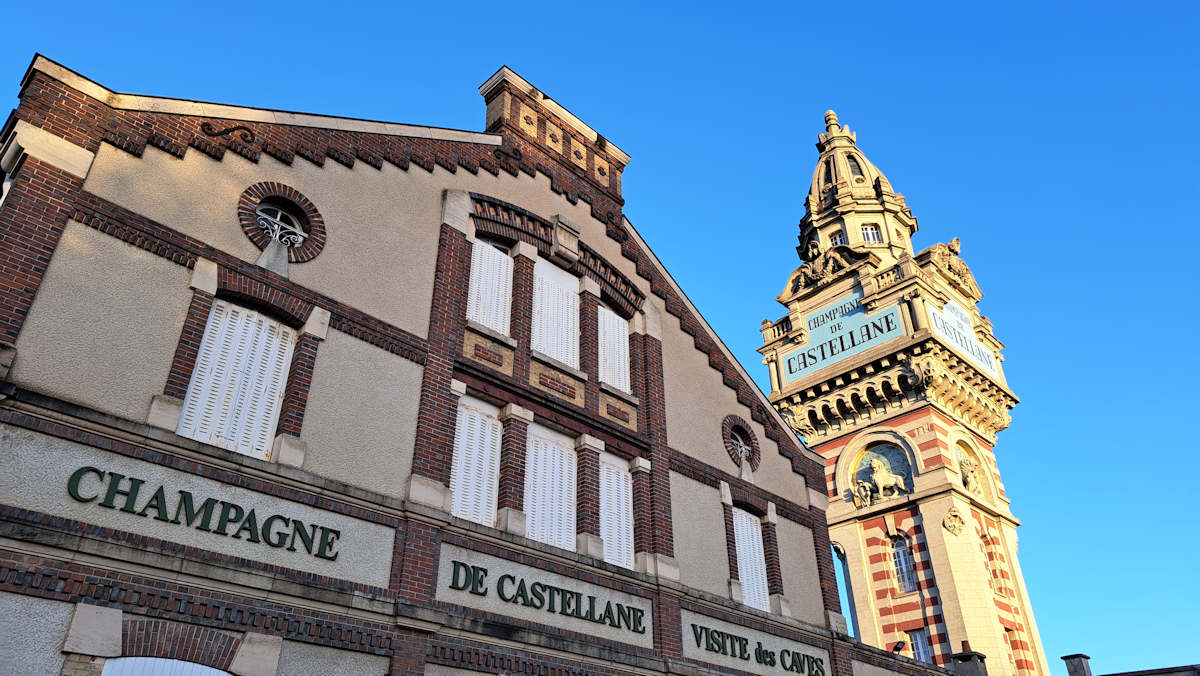
Develop your Champagne curriculum freestyle
Obtaining a proper Champagne education when in Epernay or anywhere in the winegrowing region requires getting beyond the branding and the marketing in order to truly taste and understand the variety of sparkling wines called Champagne.
Major brands do dominate the avenue, including major assets within the LVMH wine portfolio, while smaller family-operated and independent producers also have a presence. All can be enjoyable and instructive. If you do opt to visit a big-brand producer, also visit one that’s lesser known or unknown to you. There are thousands of different Champagnes available, so try to discover what defines your taste and style.
Did you say thousands? Yes, I did.
There are nearly 370 producers known as Champagne “houses,” those that control the resources requires for their own production and market internationally. (See here for more detailed definition of a Champagne house.) These houses represent more than two-thirds of Champagne sales and more than 85% of exports. Each has its own style or styles and produces a range of sparkling wines. Many are referred to as grandes marques (big-brand) producers but of the 370 you may have only heard of how many? Six? Maybe a dozen tops? Some are small, even tiny. Most of the world knows Champagne through the marketing and availability of just a few dozen of the houses.
Here in France, however, we naturally have more access to the varied world of Champagne. Beyond those few dozen and beyond producers designated as “houses,” there are dozens of cooperatives marketing Champagne and hundreds of independent producers, and grapes are grown by more than 16,000 growers. Some producers without a presence on Avenue de Champagne have shops in town where you can get acquainted with their winemaking craftsmanship. (In Epernay you won’t necessarily come across all of the major brands that you’d find at home. Reims is the other major hub for international brands.) If you only focus on brand—even if your choices are limited at home—without tasting a great many, you risk being a sparkling wine snob, proclaiming admiration for a favorite brand without being able to explain why. Better to be a sparkling wine snob with the knowledge to back it up, whether you’ve got a favorite brand or not.
Just think how impressed your friends will be when you say, “I tend to like a Champagne that’s 50% pinot noir and 50% chardonnay, with no more than 5 grams of sugar. At least with certain hors d’oeuvres. As a straight aperitif I prefer a blanc de blancs. But I did once encounter a charming pinot meunier rosé that I’ve been looking for ever since. Of course, I’ll be happy with whatever you’re serving—I do like a good Champagne.”
Well, maybe your friends won’t be impressed, but I will.
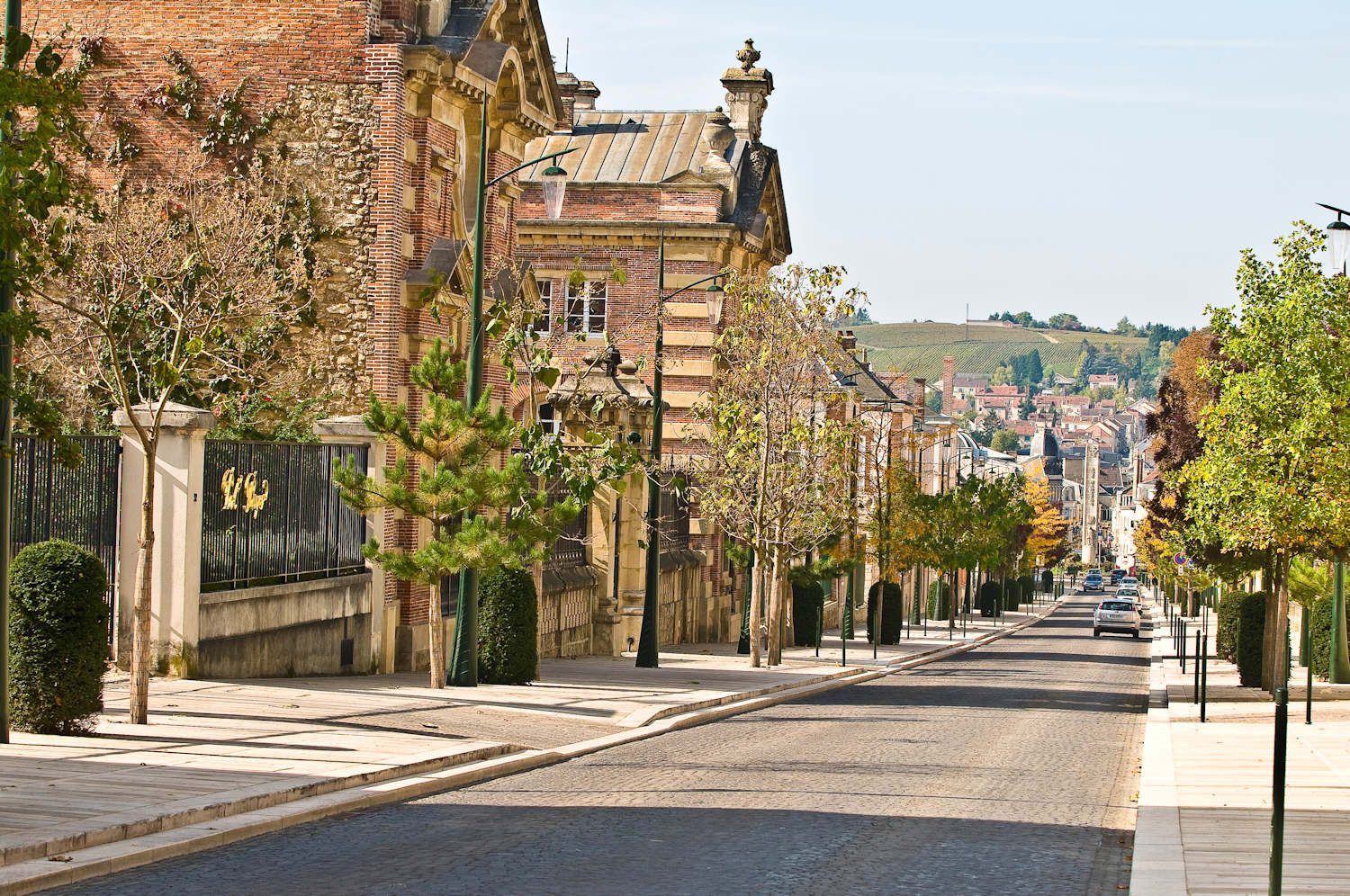
In the town center, a few blocks from the start of Avenue de Champagne, the wine bar and shop Les Grands Vins de France can serve as a beyond-the-brand Champagne education in and of itself or a good place for your final exam. Ask for a tasting according to grape variety and/or sugar content to find your preference, then ask for the brands that correspond with that preference.
Use your time in Epernay to visits several producers, whether glitzy and earthy, mineral or fruity, from different areas of the region, for blanc de blancs, blanc de noirs, blended (and in various percentages), rosé, with varying amounts of added sugar, from this part of the vine-growing region or another, with some oak-barrel ageing or (more likely) not, organic, biodynamic or whatever, vintage or not.
Do I have to drink all of those for coursework? Certainly not. Drink with moderation, of course, and pace yourself. You don’t have to finish every glass. But isn’t it reassuring to know that you won’t be driving today and are unlikely to get lost in a town this size?
Which reminds me of something my friend Guillaume once said when we were leaving a wine fair in Paris: “How much wine can you really drink without just wanting a beer?” A lot, was my answer. But if a member of your travel group is anything like Guillaume, note that Epernay has a craft brewery, Tête de Chou, 1 bis avenue Foch, a 10-minute walk from the center. It may sound sinful to mention beverages with bubbles other than those in Champagne if you’ve come this far, but there you have it, craft beer served in the brewer’s taproom Thurs.-Sat. 5:30PM to midnight.
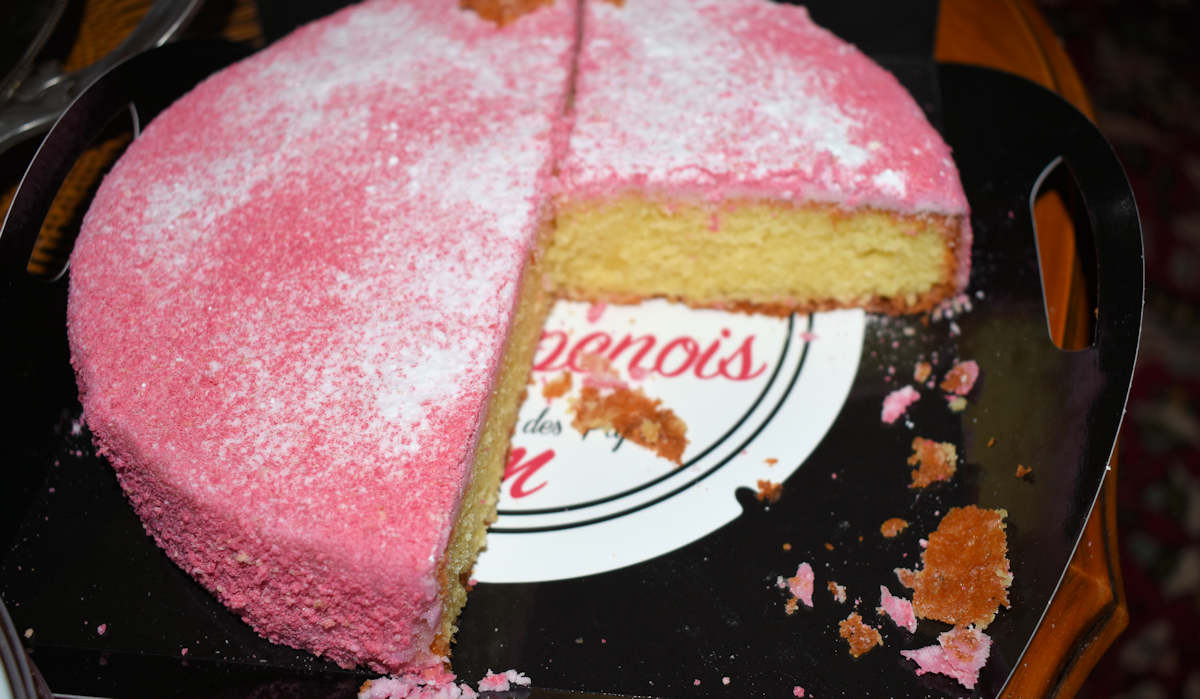
A pink pastry break: le moelleux champenois
Personally, I’d seek out pastry in Epernay before looking for beer. As a break from Champagne tasting (or to accompany it), Epernay and the surrounding region offer the opportunity to enjoy a pastry or cake that you won’t find elsewhere. It’s called the moelleux champenois. Moelleux means soft and champenois means from Champagne. The soft pastry from Champagne is therefore a nod the dry harder pink biscuits (aka Champagne biscuits or pink biscuits of Reims) that are traditionally associated with high tea Champagne and after-dinner delicacy.
In 2019 by a group of six boulangers-pâtissiers belonging to the Bakery Federation of the Marne came together in an effort to create a pastry that would be distinctly regional. The result is the moelleux champenois, made of eggs, sugar, almond, butter, flour, marc de Champagne (a brandy made from the residue of Champagne wine grapes after pressing), baking powder, with crumbled pink biscuit on top (egg whites, sugar, flour, baking powder, coloring). Only members of the Bakery Federation are authorized to use the recipe to make moelleux champenois under that name. Currently, about 40 do. On our trip, it made for a nice pairing with de Castellane rosé both for taste and for color, but it also goes well with coffee or tea.
Ours was actually a triple pairing of moelleux champenois, De Castellane rosé and an encounter with Loïc Maingre, who was among the original development team for the pastry. He and his wife Céline operate the pastry shop Au Bonheur des Papilles. 31 Rue de la Porte Lucas, on the western edge of the inner town. Closed Wed. and Thurs.
Maingre explained that since pink (Champagne) biscuits have long shelf-life, the Bakery Federation wanted to create something that did as well. The moelleux champenois, he said, has a shelf-life of 11 days, but I can’t imagine anyone holding onto one for very long. Immediate consumption is more like it, especially if you purchase an individual portion (3.50€) but even a full cake (13€) if traveling with friends. (Admittedly, I did hold on to one individual portion to enjoy with breakfast two days later when back home in Paris.)
As to the recipe for pink biscuits, Vincent Dallet, a well-known pastry chef and chocolatier in Epernay (who is not among the group making moelleux champenois), shared it with me for this article a while back.

Restaurants and Eateries
La Banque, 40 rue du Général Leclerc. In a former bank building, a polished and classy brasserie, well situated for either lunch or dinner. Open daily.
La Cave de l’Avenue, 5 avenue de Champagne. An easy-going restaurant at lunchtime and a wine bar after 6PM, La Cave belongs to the Bergère family, owners of Champagne A. Bergère. Closed Sun. and Mon. While the restaurant and wine bar naturally serve the family Champagne, a cellar tour and formal tasting can be had further up the avenue at #40.
La Cave à Champagne, 16 rue Gambetta. An Epernay institution for hearty traditional fare. Closed Tues. and Wed.
Le Théâtre, 8 place Mendès France. Traditional gastronomy by the theater at the circle near the train station. Closed Wed. as well as evenings Tues. and Sun.
There are numerous easy-going options for a meal or a snack in the compact town center, including bakeries, cafés and pizzerias.
Accommodations
There are three reasons that Epernay makes for a nice overnight for slow travelers: 1. To take a pre-dinner nap in your hotel or B&B after an afternoon of touring and tasting. 2. To enjoy a leisurely dinner (with more Champagne tasting) in town. 3. To take a genteel stroll along the avenue after nightfall.
Since this article concerns Epernay as a carless Champagne excursion, I’ve only selected accommodations that are within walking distance of the train station. Luxury accommodations and other worthy options are also found in the surrounding villages and by the vineyards.
Hotels
La Villa Eugène, 84 avenue de Champagne. Epernay’s only 5-star hotel, is located several hundred yards beyond the main stroll way of Avenue de Champagne, just past Mercier. It occupies a 19th-century mansion that once belonged to Eugène Mercier himself. Traditional rooms with a touch of elegance. Bar. Small outdoor heated pool. A wooded park behind the house. The hotel is a mile from the heart of the town and the train station, so while it isn’t far from the action, travelers on a car-free overnight may feel that they’re slightly off-center. Without discouraging a stay for Epernay-only foot travelers, I see this more as a place for settle in for two or more nights while also visiting the villages and vineyards in the vicinity with your own car or with a car service, taxi or organized tour.
Hotel Jean Moët, 7 rue Jean Moët, a well-situated 4-star in heart of town, a 4-minute walk from the train station, with a Champagne bar next door.
Hôtel de Champagne, 30 rue Eugène Mercier. A nice and simple inexpensive 3-star near the center of town, a 7-minute walk from the station.
Le Clos Raymi, 3 rue Joseph de Venoge. A 15-minute walk from the station, behind Avenue de Champagne, this pricier 3-star is a 7-room hotel of character in a 19-century mansion that once belonged to the Chandon family.
B&Bs
Epernay is actually more of a B&B destination for now, though not all will allow guests for only one night.
Le 25 Bis by Leclerc Briant, 25 bis avenue de Champagne, situated 500 yards up the avenue, about mid-way along the strolling zone. The Leclerc Briant Champagne house (200,000 bottles/year) has since 2012 been owned by the American couple Mark Nunnelly (from the world of finance) and Denise Dupré (from the world of hospitality management). They’re associated with Frédéric Zeimett, a French partner native to the region, for the production of their wines. The couple also owns the 5-star Royal Champagne hotel that overlooks the southern portion of the Mountain of Reims. Their chic B&B in Epernay has five large, formally elegant rooms and more service possibilities than a typical B&B. Priced accordingly. Options include taking over the entire house with a group of friends and, in that case, hiring a private chef, and, of course, a tour of the Leclerc Briant production headquarters which are situated on the western edge of Epernay where the vineyards begin.
Le Bubble 8, 8 rue des Berceaux, an excellent location on a calm street near restaurants, bars, bakeries and other shops, just a 3-minute walk from the start of Avenue de Champagne. Owner Pascale Lelong-Macra had a career in finance before purchasing the honorable solicitors’ Maison des Notaires and transforming it into five apartment B&Bs. The spacious, well-appointed studios and apartments with clean lines and character have kitchens or kitchenettes and so are especially adapted to a stay of several days or more. It’s nevertheless also a welcoming place for a short stay (there’s a 2-night minimum). Without the pretentions of a full-service B&B such as Le 25 Bis, Lelong-Macra’s son Clement is quite capable, with advance organization, of driving guests out to the villages and vineyards in the surrounding area for Champagne visits according to his itinerary or your own. (His is not a taxi service but a touring service for those staying at Le Bubble 8 and other apartments rentals managed by the family.)
Parva Domus, 27 avenue de Champagne. Parva domus magna quies is Latin for “small house, big rest,” which is what I enjoyed in the attic bedroom at Madame Rimaire’s plain, old-fashion, friendly B&B quietly located midway along the prestigious avenue, a 10-minute walk from the station. Magna Quies is the name of a sister B&B up the avenue at #49.
La Cave de l’Avenue, 5 avenue de Champagne, noted above as a lunchtime restaurant and evening wine bar belonging to the Bergère family (Champagne A. Bergère), is also a B&B with an excellent location for strolls day or night along Champagne Avenue and in the heart of Epernay.
Further logistical considerations
As I’ve said, a day trip to Epernay requires little advance planning, perhaps just a reservation for a cellar tour or two if you want and a hotel or B&B reservation if you intend to spend the night.
While this article is especially intended to describe an easy-walking, car-free Champagne excursion from Paris, whether as a day trip or an overnight, before returning to Paris, you can see on the map above its proximity to Reims, the historic capital of the Champagne region.
Nearly hourly trains link Epernay and Reims, a 35-minute ride to the opposite side of the Mountain of Reims. So after a day or overnight in Epernay it’s possible to continue car-free to visit the sights of Reims (cathedral, basilica, Roman arch, a great food market, and more) as well as tour other big-name Champagne houses (Taittinger, Ruinart, Pommery, Veuve Clicquot) with their impressive cellars occupying Gallo-Roman and medieval limestone quarries. As mentioned earlier, fully visiting Reims requires far more walking than in Epernay, but they are world-renown sights. From Reims you can catch a train back to Paris or continue eastward on a rail-based tour. It’s also possible to begin with a train to Reims (from either Paris or Charles de Gaulle Airport) before continuing on to Epernay then returning to Paris.
© 2022, Gary Lee Kraut

